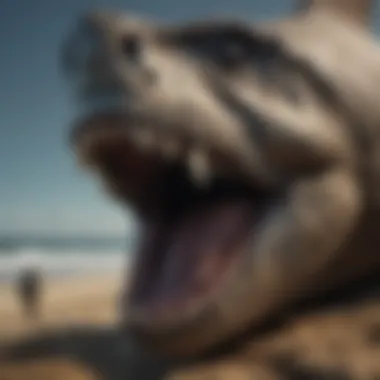Unveiling the Majestic Size of the Ancient Megalodon Tooth


Rock and Fossil Identification
Megalodon teeth are often found embedded in rock formations and fossilized sediments, making rock and fossil identification a crucial aspect for collectors. Understanding the types of rocks and fossils where these impressive teeth are preserved is essential. Look for characteristics such as texture, color, and composition to identify the specific sedimentary layers or marine deposits where megalodon teeth are typically found. Utilize tools such as geological hammers, chisels, and brushes to carefully extract and uncover these precious fossils.
Collecting Tips and Techniques
To enhance your collection of megalodon teeth, follow best practices for collecting these prized specimens. Research and locate prime collecting sites where these fossils are abundant, such as coastal cliffs or riverbanks with rich fossil deposits. Exercise caution and use proper safety gear when extracting specimens to prevent damage and ensure personal safety. Employ techniques like screen-washing or hand picking to gather these fossils effectively.
Preservation and Display
Preserving megalodon teeth is critical to maintaining their quality and longevity. Explore techniques such as cleaning with gentle brushes, conserving in a stable environment, and avoiding exposure to sunlight or moisture to prevent deterioration. Store these fossils in acid-free containers or display cases to safeguard them from damage and dust. Get creative with display ideas by showcasing these magnificent teeth in shadow boxes, alongside informational plaques highlighting their significance.
Geological Insights
Delve into the geological context surrounding megalodon teeth to gain deeper insights into their historical significance. Explore the formations and processes that led to the preservation of these fossils, such as marine sedimentation or tectonic activities. Uncover notable discoveries made in the field of paleontology regarding megalodon teeth, shedding light on the evolutionary journey of this ancient apex predator.
Introduction to Megalodon Tooth
In the vast realm of paleontology, the megalodon tooth stands out as a remarkable specimen, capturing the imagination of scientists and enthusiasts alike. The Introduction sets the stage for a deep dive into this colossal tooth, known for its enormous size and intriguing characteristics. By delving into the history, structure, and significance of the megalodon tooth, readers are provided with a comprehensive overview of this prehistoric marvel.
Discovery of Megalodon Tooth
Unearthing of Fossil Specimens
The discovery of megalodon fossil specimens is a pivotal aspect of paleontological research, shedding light on the ancient world and the massive creatures that once roamed the oceans. Unearthing these fossils involves meticulous excavation techniques and careful preservation to ensure that valuable scientific data is extracted and analyzed. The process of discovering megalodon tooth specimens provides researchers with insights into the biology and ecology of this extinct predator, enriching our understanding of prehistoric marine ecosystems.
Historical Significance
The historical significance of megalodon teeth extends beyond their scientific value, offering a window into the past and the evolution of marine life on our planet. These fossils have played a crucial role in shaping our knowledge of prehistoric creatures and have captivated historians and paleontologists for centuries. By exploring the historical significance of megalodon teeth, we can uncover tales of ancient seas and the formidable predators that once ruled these waters, providing us with a glimpse into a world long gone.
Physical Characteristics


Size Comparison to Modern Predators
A striking feature of the megalodon tooth is its size, dwarfing those of modern predators like the great white shark. Comparing the dimensions of these teeth highlights the sheer magnitude of the megalodon, showcasing its dominance as a top marine predator during its time. Understanding the size comparison to modern predators offers valuable insights into the evolutionary adaptations that allowed the megalodon to thrive in ancient oceans.
Tooth Structure and Composition
The intricate structure and composition of megalodon teeth reveal fascinating details about the biology and behavior of this extinct species. Studying the tooth structure uncovers clues about the megalodon's feeding habits, bite mechanics, and overall predatory strategy. By examining the composition of these teeth, scientists can unravel mysteries about the megalodon's diet, ecology, and evolutionary adaptations, providing a deeper understanding of this enigmatic predator.
Geological Significance
Ancient Marine Ecosystems
The presence of megalodon teeth in ancient marine ecosystems offers a glimpse into the diverse and dynamic world of prehistoric oceans. By studying these fossils within the context of their geological surroundings, researchers can reconstruct the habitats and ecological niches that the megalodon inhabited. Exploring their significance in ancient marine ecosystems unveils a tapestry of interconnected species and environmental conditions that shaped the evolution of this formidable predator.
Megalodon's Role in Evolution
The megalodon's role in evolution is a subject of intrigue and ongoing research, influencing our understanding of marine biodiversity and evolutionary history. By investigating how this apex predator impacted its environment and prey species, scientists can piece together the puzzle of its evolutionary significance. Unraveling the mysteries of the megalodon's role in evolution sheds light on the complex interplay between predator and prey, highlighting the crucial role that large predators play in shaping marine ecosystems over time.
Analyzing the Size of Megalodon Tooth
In this section, we will delve deep into the significance of comprehensively examining the size of the Megalodon tooth. Understanding the dimensions and measurements of these colossal teeth is crucial in unraveling the mysteries surrounding these ancient predators. By analyzing the size of the Megalodon tooth, we can gain insights into its evolution, feeding habits, and ecological importance.
Dimensions and Measurements
Length, Width, and Weight
The dimensions of the Megalodon tooth, including the length, width, and weight, play a pivotal role in comprehending the sheer magnitude of this prehistoric predator. Measuring up to several inches in length and exhibiting formidable weight, these teeth bear witness to the powerful jaws of the Megalodon. The length signifies the striking reach of the tooth, while the weight underscores the robust nature of this apex predator. Understanding these measurements provides vital information on the Megalodon's predatory behavior and its place in the ancient marine ecosystem.
Comparison to Great White Shark Tooth
Drawing comparisons between the Megalodon tooth and the Great White Shark tooth offers unique insights into the evolutionary adaptations of these apex predators. While the Megalodon tooth dwarfs that of the Great White Shark in size and weight, both exhibit exceptional structural integrity. The serrated edges of the Megalodon tooth and the distinctive shape of the Great White Shark tooth serve specific feeding functions unique to each species. Contrasting these teeth sheds light on the divergent evolutionary paths taken by these formidable predators.


Tooth Growth and Function
Growth Patterns and Replacement
The growth patterns and replacement mechanisms of Megalodon teeth present intriguing facets of their biology. With teeth being continually replaced throughout their lives, Megalodons displayed a fascinating pattern of dental development. Studying the growth patterns and replacement process offers crucial insights into the lifespan and behavior of these ancient predators. The ability to regenerate such massive teeth speaks volumes about the evolutionary adaptations honed by the Megalodon over millions of years.
Bite Mechanics and Prey Capture
The mechanics of the Megalodon's bite and its strategy for capturing prey provide a window into the hunting prowess of this apex predator. With a bite force capable of pulverizing bone, the Megalodon employed a unique approach to subduing its prey. Understanding the intricacies of its bite mechanics and prey capture tactics illuminates the predatory techniques honed by this ancient behemoth. Exploring how the Megalodon used its massive teeth for predation unveils the level of specialization that characterized its role in the ancient oceans.
Implications of Tooth Size
Feeding Behavior and Diet
The size of Megalodon teeth offers valuable insights into the feeding behavior and dietary preferences of these ancient predators. By examining the wear patterns and fractures on the teeth, researchers can infer the types of prey consumed by Megalodons. The massive size of the teeth suggests a diet that comprised large marine mammals, showcasing the apex predatory nature of these colossal creatures. Deciphering the feeding behavior and diet of Megalodons contributes to our understanding of the intricacies of ancient marine ecosystems.
Ecological Role in Ancient Oceans
The ecological role played by Megalodons in ancient oceans transcends their formidable size and predatory capabilities. As apex predators, Megalodons occupied a crucial niche in marine ecosystems, regulating the populations of marine species below them in the food chain. By examining the ecological interactions influenced by Megalodons, we can appreciate the ripple effects their presence had on biodiversity and ecosystem dynamics. Investigating the ecological role of Megalodons offers a holistic view of their significance in shaping the ancient oceans.
Comparing Megalodon Tooth to Other Species
In this section of the article, we delve into the significance of comparing the Megalodon tooth to other species. By juxtaposing the features of the Megalodon tooth with those of other creatures, we can gain valuable insights into its adaptation and role in the ancient ecosystem. This comparative analysis sheds light on the unique characteristics of the Megalodon tooth and how it sets this prehistoric predator apart from other species.
Prehistoric Megafauna
Saber-Toothed Cats: Exploring the realm of Saber-Toothed Cats unveils a fascinating aspect of prehistoric megafauna. These majestic felines possessed dagger-like teeth designed for precise slashing, indicating a specialized predatory lifestyle. The distinctive feature of Saber-Toothed Cats lies in their elongated canines, which enabled them to take down large prey with ease. By examining their dental structure, we can draw parallels to the Megalodon tooth, showcasing evolutionary adaptations for efficient hunting.
Ancient Marine Reptiles: Ancient marine reptiles present another facet of prehistoric megafauna. These reptilian giants, such as ichthyosaurs and mosasaurs, ruled the ancient seas with formidable teeth adapted for catching fish and other marine creatures. The key characteristic of Ancient Marine Reptiles lies in their diversity of tooth shapes, reflecting their varied dietary preferences and habitats. Understanding these ancient predators provides a broader perspective on the evolutionary arms race that shaped the marine ecosystem alongside the Megalodon.
Modern Animal Teeth


Elephants and Mammoths: The comparison extends to modern animal teeth, with elephants and mammoths offering intriguing parallels. These massive herbivores feature continuously growing molars, indicating a herbivorous diet reliant on grinding tough vegetation. The key characteristic of Elephants and Mammoths lies in their dental longevity, showcasing adaptations for a herbivorous lifestyle. Examining their teeth highlights the contrast between herbivorous and carnivorous dental structures, emphasizing the Megalodon's carnivorous tendencies.
T-Rex and Carnivorous Dinosaurs: Transitioning to carnivorous dinosaurs like T-Rex provides a different perspective on tooth structures. These apex predators wielded serrated teeth designed for tearing flesh, reflecting a different evolutionary path from the Megalodon. The key characteristic of T-Rex and Carnivorous Dinosaurs lies in their predatory morphology, optimized for capturing and devouring prey efficiently. Contrasting their tooth adaptations with those of the Megalodon showcases the diversity of predators throughout evolutionary history.
Preservation and Display of Megalodon Teeth
Within the intriguing realm of the megalodon tooth, the preservation and display hold paramount importance in shedding light on the prehistoric world. As magnificent relics of a bygone era, megalodon teeth offer invaluable insights into the anatomy, behavior, and ecological role of this colossal predator. Preservation ensures that these remarkable specimens are protected from degradation and retain their scientific value for future study and appreciation.
When delving into the preservation aspect, meticulous techniques are employed to enhance the longevity and authenticity of megalodon teeth. Cleaning and conservation are vital processes in safeguarding these fossils, maintaining their structural integrity, and preventing deterioration over time. Additionally, proper preservation honors the heritage of these teeth, preserving them as tangible links to a past era.
In the context of display, showcasing megalodon teeth serves not only as a visual spectacle but also as a means of education and fascination. The exhibition of these imposing teeth allows enthusiasts, researchers, and the general public to marvel at the sheer size and formidable nature of the megalodon. Moreover, displaying these teeth in collections or museums contributes to the dissemination of knowledge about prehistoric marine life and fosters a deeper connection to our evolutionary history.
The section on Preservation and Display of Megalodon Teeth navigates through the intricate processes and considerations involved in safeguarding and exhibiting these majestic artifacts. By exploring the dynamics of preservation and the significance of display, readers are invited to immerse themselves in the world of megalodon teeth and appreciate the magnitude of their existence.
Concluding Remarks
The significance of Concluding Remarks in this extensive exploration of the Megalodon Tooth is paramount. By summarizing the key findings and insights unearthed throughout the article, the Concluding Remarks serve as the final piece of the puzzle, bringing cohesion to the narrative. These remarks provide a holistic view of the Megalodon Tooth's enormous size, physical characteristics, geological significance, and comparisons to other species. They encapsulate the awe-inspiring dimensions, structure, and evolutionary implications of this prehistoric predator's tooth, leaving readers with a profound understanding of its place in the animal kingdom and the ancient marine ecosystems. The Concluding Remarks act as a guidepost, directing readers towards a deeper appreciation of the Megalodon Tooth's importance and impact.
Significance of Megalodon Tooth
Symbol of Prehistoric Power
The Symbol of Prehistoric Power embodied by the Megalodon Tooth holds a unique position in the realm of ancient predators. It represents not just a tooth but a symbol of dominance and ferocity, showcasing the raw power of one of nature's most formidable predators. This symbolism resonates with enthusiasts and researchers alike, encapsulating the sheer force and mastery that the Megalodon wielded in ancient oceans. The Symbol of Prehistoric Power encapsulates the primal strength and authority of the Megalodon, making it a compelling focal point in discussions surrounding prehistoric predators and their evolutionary significance.
Impact on Paleontological Studies
The Impact on Paleontological Studies stemming from the study of Megalodon Teeth is profound and far-reaching. These colossal teeth offer valuable insights into the ancient marine ecosystems, feeding behaviors, and evolutionary processes of the Megalodon. By analyzing these fossilized remains, paleontologists can piece together a clearer picture of prehistoric oceans and the interactions between apex predators and their environments. The Megalodon Tooth's impact on paleontological studies opens doors to new avenues of research and understanding, shedding light on the dynamics of ancient food chains and the adaptations of marine creatures over millions of years.
Future Research and Discoveries
Uncovering Megalodon's Mysteries
Uncovering Megalodon's Mysteries delves into the cryptic enigmas that shroud this prehistoric predator. By uncovering new evidence and refining existing knowledge, researchers aim to unravel the mysteries surrounding the Megalodon's behaviors, habitats, and extinction. This aspect of research contributes significantly to our understanding of the Megalodon's evolutionary trajectory and its ecological role in ancient oceans. Delving into these mysteries offers a glimpse into a bygone era ruled by giant sharks, providing a richer tapestry of information for future generations to explore.
Exploring Other Fossilized Remains
Exploring Other Fossilized Remains beyond the Megalodon Tooth opens up a treasure trove of paleontological wonders. By studying a diverse array of fossilized remains, scientists can piece together the puzzle of prehistoric life on Earth, ranging from ancient mammals to extinct reptiles. This exploration not only broadens our understanding of evolutionary history but also showcases the intricate web of life forms that once populated the planet. By delving into these fossilized remains, researchers can draw parallels, contrasts, and connections between different species, painting a vivid picture of Earth's ancient past.







